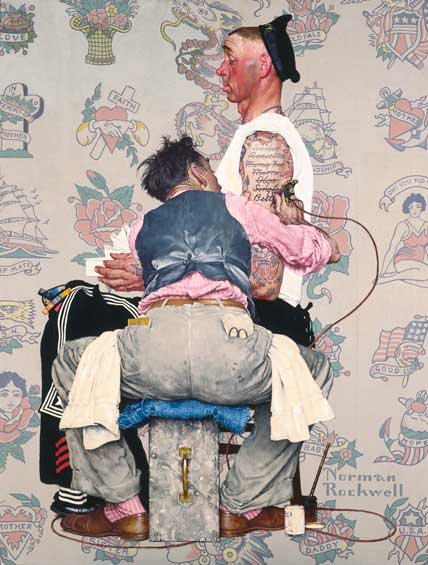
Norman Rockwell (American, 1894–1978). The Tattoo Artist, 1944. Oil on canvas, 431⁄8 x 331⁄8 in. (109.5 × 84.1 cm). Brooklyn Museum, Gift of the artist, 69.8

Norman Rockwell (American, 1894–1978). The Tattoo Artist, 1944. Oil on canvas, 431⁄8 x 331⁄8 in. (109.5 × 84.1 cm). Brooklyn Museum, Gift of the artist, 69.8

Left: John Stuart Cloud (American, 1914–2007). Photograph for The Dugout (detail), 1948. Gelatin silver print, 913⁄16 x 79⁄16 in. (24.9 × 19.2 cm). Norman Rockwell Art Collection Trust. Norman Rockwell Licensing, Niles, Illinois
Right: Norman Rockwell (American, 1894–1978). The Dugout, 1948. Cover illustration for The Saturday Evening Post, September 4, 1948.Transparent and opaque watercolor over graphite on two sheets of conjoined cream, moderately thick, moderately textured wove paper, 19 × 1713⁄16 in. (48.3 × 45.2 cm). Brooklyn Museum, Gift of Kenneth Stuart, 71.124. ©1948 SEPS: Curtis Publishing, Indianapolis
Rockwell traveled to Boston with Saturday Evening Post art editor Ken Stuart to photograph fans during a doubleheader between the Boston Braves and the visiting Chicago Cubs at Braves Field. Additional images taken in the studio were used to fill out the jeering crowd. Rockwell himself can be found in the upper left corner of the painting. The artist typically used oil paints for his final work, but this is a rare example done in watercolor.

Top: Louie Lamone (American, 1918–2007). Photographs for New Kids in the Neighborhood, 1967. Norman Rockwell Art Collection Trust, Norman Rockwell Licensing, Niles, Illinois
Bottom: Norman Rockwell (American, 1894–1978). New Kids in the Neighborhood, 1967. Look magazine, May 16, 1967. Tear sheet, 13 × 201⁄2 in. (33 × 52.1 cm). Norman Rockwell Museum Archival Collections. Norman Rockwell Licensing, Niles, Illinois
This illustration for an article on the changing racial profile of America’s suburbs offered Rockwell an opportunity to again feature children—favored subjects throughout his long career.

Left: Gene Pelham (American, 1909–2004). Photograph for Shuffleton’s Barbershop, 1950 (printed 2009). Inkjet print, 115⁄16 x 715⁄16 in. (28.7 × 20.2 cm). Norman Rockwell Art Collection Trust. Norman Rockwell Licensing, Niles, Illinois
Right: Norman Rockwell (American, 1894–1978). Shuffleton’s Barbershop, 1950. Cover Illustration for The Saturday Evening Post, April 29, 1950. Oil on canvas, 453⁄4 x 421⁄2 in. (116.2 × 108 cm). Berkshire Museum, Pittsfield, Massachusetts. ©1950 SEPS: Curtis Publishing, Indianapolis
“There were details, accidents of light, which I’d missed when I’d been able to make only quick sketches of a setting. For example in Rob Shuffleton’s barbershop in East Arlington, Vermont: where Rob hung his combs, his rusty old clippers, the way the light fell across the magazine rack, his moth-eaten push broom leaning against the display cases of candy and ammunition, the cracked leather seat of the barber chair with the stuffing poking through along the edges over the nickel-plated frame. A photograph catches all that.”—Norman Rockwell (1960)
Norman Rockwell: Behind the Camera
November 19, 2010–April 10, 2011
Beginning in the late 1930s, Norman Rockwell adopted photography as a tool to bring his illustration ideas to life in studio sessions. Working as a director, Rockwell carefully staged his photographs, selecting props and locations, choosing his models, and orchestrating every detail. He created an abundance of photographs for each new subject, sometimes capturing complete compositions and other times combining separate pictures of individual elements. These photographs were the focus of a recently completed two-year project at the Norman Rockwell Museum that preserved and digitized almost 20,000 negatives. For the first time, Norman Rockwell: Behind the Camera presents these study photographs alongside his paintings, drawings, and related tear sheets to offer a fascinating look at the artist’s working process.
Norman Rockwell: Behind the Camera has been organized by the Norman Rockwell Museum in Stockbridge, Massachusetts, in collaboration with guest curator Ron Schick.
The Brooklyn Museum presentation is organized by Sharon Matt Atkins, Managing Curator of Exhibitions.



